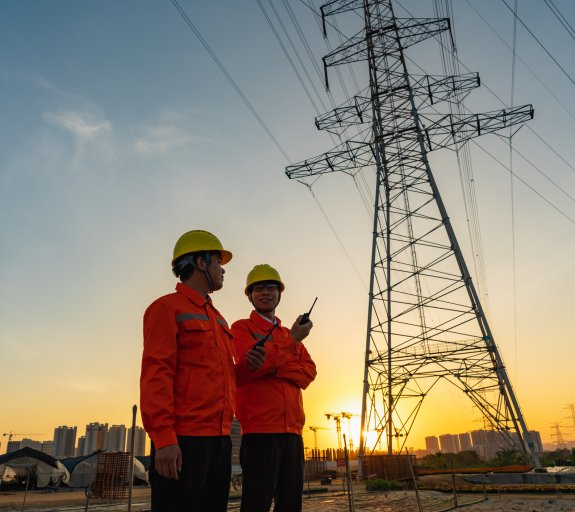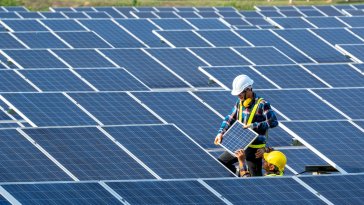
Leading the charge: Surge in US data centre growth is powering renewable energy investment opportunities
KEY POINTS
From the meteoric rise in cloud-based computing to the exponential growth of artificial intelligence (AI), technological developments are continuing apace and demanding an ever-increasing amount of electricity to power the data centres behind them.
Data centres - physical sites housing servers, networks, storage infrastructure and other related hardware – require a huge amount of energy to operate. In 2022 globally, data centres consumed an estimated 460 terawatt hours (TWh) of electricity globally and this is forecasted to reach more than 1,000 TWh in 2026 - roughly equivalent to Japan’s entire annual electricity consumption.1 By 2034, data centres worldwide are expected to use 1,580 TWh, about the same as India’s entire energy demand.2
Presently there are more than 10,000 data centres located around the globe, with half of them in the US where they are estimated to consume around 4% of all the electricity generated in the world’s largest economy.3
That’s predicted to rise to as much as 9.1% of all US electricity generated by 2030 but the anticipated figure is far more in some areas, such as up to 50% in Virginia, where the largest concentration of data centres is found.4
Other states housing numerous data centres - including Texas and California - typically enjoy lower land prices, strong internet connection, as well as the availability of skilled labour and an abundance of energy sources – increasingly, renewable energy such as wind and solar.
Renewable connections
Renewables are both the cheapest, and cleanest, way to meet the growing power requirement for data centres. As a result, many large technology companies are partnering with suppliers and utilities to support the development of renewable energy. For example, Microsoft is teaming up with Brookfield Renewable Partners, a renewable energy developer, to add renewables capacity to power its US and Europe data centres,5while Amazon recently bought a nuclear-powered data centre in Pennsylvania from Talen Energy.6
However, co-locating data centres with nuclear power facilities is unlikely to be a scalable solution with few other suitable sites and questions regarding prioritising data centre consumption ahead of local communities and businesses.
Hyperscalers – the term given to large tech companies operating huge global networks of data centres – are likely to want to move quickly and at scale to avoid losing market share in AI or cloud computing; this favours larger renewable energy companies who have already demonstrated development capabilities and have existing project pipelines enabling fast delivery.
Companies are also notably signing agreements to scope out long term partnerships that are mutually beneficial for suppliers and customers and also provide a degree of forward visibility for investors. Amazon, Microsoft, Meta and Google are the four largest purchasers of corporate renewable energy power purchase agreements (PPAs)7, essentially a long-term contract that locks in electricity prices, giving visibility and a degree of security to both the buyer and seller. PPA rates for renewables are rising and reflect evolving supply/demand dynamics, as well as potential upside for the suppliers.8
Another consideration is the strain on water resources in areas hosting data centres as they need tens or hundreds of thousands of gallons of water to cool their equipment. Data centres are not fully circular – there is leakage from systems as water is re-circulated – but are becoming more sustainable as equipment becomes more efficient. Furthermore, tech companies like Amazon are aiming to be ‘water positive’ – returning more water to communities and the environment than it uses in its data centres – by 2030.9
- {https://iea.blob.core.windows.net/assets/18f3ed24-4b26-4c83-a3d2-8a1be51c8cc8/Electricity2024-Analysisandforecastto2026.pdf;Electricity 2024, International Energy Agency, January 2024}
- {https://www.bloomberg.com/graphics/2024-ai-data-centers-power-grids/;AI’s Insatiable Need for Energy Is Straining Global Power Grids (bloomberg.com)}
- {https://www.epri.com/research/products/000000003002028905;Powering Intelligence: Analyzing Artificial Intelligence and Data Center Energy Consumption}, Electric Power Research Institute, 2024
- {https://www.epri.com/research/products/000000003002028905;Powering Intelligence: Analyzing Artificial Intelligence and Data Center Energy Consumption}, Electric Power Research Institute, 2024
- {https://www.cnbc.com/2024/05/01/microsoft-brookfield-to-develop-more-than-10point5-gigawatts-of-renewable-energy.html;Microsoft, Brookfield to develop more than 10.5 gigawatts of renewable energy (cnbc.com)}
- {https://www.ans.org/news/article-5842/amazon-buys-nuclearpowered-data-center-from-talen/;Amazon buys nuclear-powered data center from Talen -- ANS / Nuclear Newswire}
- {https://www.iea.org/energy-system/buildings/data-centres-and-data-transmission-networks;Data centres & networks - IEA}
- {https://www.woodmac.com/news/opinion/welcome-to-the-new-ppa-market-paradigm/;Welcome to the new PPA market paradigm | | Wood Mackenzie}
- {https://sustainability.aboutamazon.com/natural-resources/water;Water Stewardship - Amazon Sustainability (aboutamazon.com)}
Fortified backdrop
This increasing demand for renewable energy, backed by government policy, underlines what we believe is a potential long-term investment trend. The US remains a supportive environment for renewable energy investment; including, among other policies, the 2022 Inflation Reduction Act (IRA) – a subsidy initiative, which promotes decarbonisation - and 2021’s Bipartisan Infrastructure Law, which aims to bolster wastewater infrastructure as well as improve the electricity grid. New investment in clean energy production, as well as carbon dioxide capture and removal and other forms of industrial decarbonisation, increased 34% in the past two years since the IRA was signed into law, compared to the preceding two-year period.10
There are potential opportunities across the spectrum, from equipment companies that manufacture the cables and transformers that carry wind or solar power to the grid and then on to the data centres, such as Eaton, and renewable energy developers like Brookfield and NextEra.
While Eaton does make transformers it also provides data centre management software, to help hyperscalers improve operational efficiency, prevent power outages and more. As power demand is rising, companies that help drive energy efficiency are likely to be increasingly on many investors’ radars.
There is also scope for growth in the outsourced engineering and procurement sector, among companies that design, build and maintain the power network infrastructure, such as Quanta Services.
Quanta is providing infrastructure solutions for the SunZia Southwest Transmission Project, an 885-kilometre-long transmission line expected to be the US’s biggest-ever clean energy infrastructure project.11 In addition, Quanta’s recent acquisition of Cupertino, an electrical infrastructure specialist, increases its exposure to the data centre market, giving it scale in what is a relatively fragmented market. This is also a market with high barriers to entry – including skilled labour.
Scale is another barrier to entry, favouring larger players in the industry such as Florida-based NextEra Energy. >With a presence in 49 US states, we see it as being able to leverage its scale to secure attractive prices in buying equipment such as solar panels in large quantities, and secure potentially better interest rates on debt.12
We believe appetite for renewable energy will only continue to grow, reflecting the continued demand for greater capacity - not only due to its importance in mitigating climate change, but also as it offers the potential for greater energy independence, stable pricing and cost-effectiveness.
These fundamental pillars support an ongoing structural change, both in the energy transition and increase in digitalisation. In turn, this is creating potential long-term opportunities for investors in the renewable energy space and in the wide spectrum of companies that support the sector.
Companies shown are for illustrative purposes only as of 12/09/2024 and may no longer be in the portfolio later. It does not constitute investment research or financial analysis relating to transactions in financial instruments, nor does it constitute an offer to buy or sell any investments, products or services, and should not be considered as solicitation or investment, legal or tax advice, a recommendation for an investment strategy or a personalized recommendation to buy or sell securities.
- {https://www.cleaninvestmentmonitor.org/;The Clean Investment Monitor}
- {https://www.quantaservices.com/stories/quanta-services-selected-for-the-sunziatransmission-and-sunzia-wind-projects;Quanta Services Selected for the SunZia Transmission and SunZia Wind Projects - Quanta Services}
- {https://www.nexteraenergy.com/about-us/work.html;Work - NextEra Energy}
Disclaimer
This document is for informational purposes only and does not constitute investment research or financial analysis relating to transactions in financial instruments as per MIF Directive (2014/65/EU), nor does it constitute on the part of AXA Investment Managers or its affiliated companies an offer to buy or sell any investments, products or services, and should not be considered as solicitation or investment, legal or tax advice, a recommendation for an investment strategy or a personalized recommendation to buy or sell securities.
Due to its simplification, this document is partial and opinions, estimates and forecasts herein are subjective and subject to change without notice. There is no guarantee forecasts made will come to pass. Data, figures, declarations, analysis, predictions and other information in this document is provided based on our state of knowledge at the time of creation of this document. Whilst every care is taken, no representation or warranty (including liability towards third parties), express or implied, is made as to the accuracy, reliability or completeness of the information contained herein. Reliance upon information in this material is at the sole discretion of the recipient. This material does not contain sufficient information to support an investment decision.
Issued in the UK by AXA Investment Managers UK Limited, which is authorised and regulated by the Financial Conduct Authority in the UK. Registered in England and Wales, No: 01431068. Registered Office: 22 Bishopsgate, London, EC2N 4BQ.
In other jurisdictions, this document is issued by AXA Investment Managers SA’s affiliates in those countries.
© 2024 AXA Investment Managers. All rights reserved





